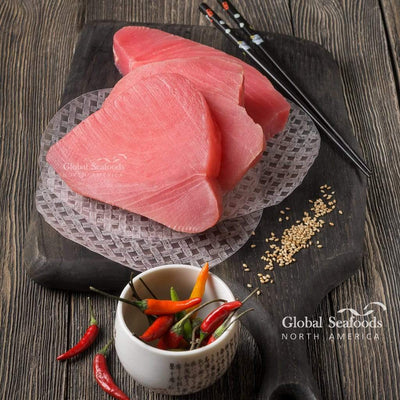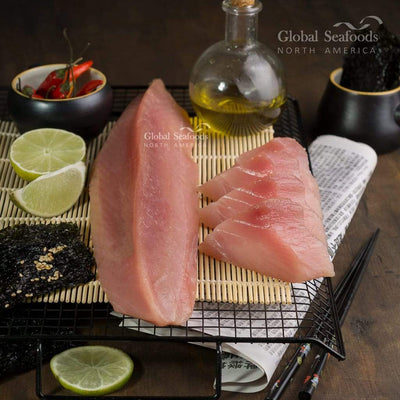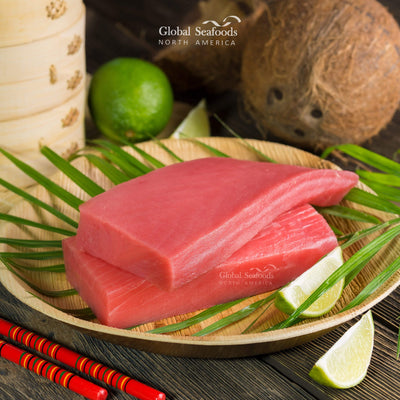13 Benefits Of Tuna

13 Health Benefits of Tuna
Tuna is a very interesting fish and has endothermic abilities that allow it to transverse waters that are drastically different in temperature. It can increase its body temperature to up to 20 C above that of the surrounding water and has a sleek, streamlined body that helps it increase its swimming speed from zero to 40 miles per hour in seconds. Tuna fish is also highly migratory and may travel thousands of miles in its lifetime.
In general, there are 15 different varieties of tuna fish, but yellowfin tuna or ahi tuna fish, bluefin, albacore, and skipjack are the most common. Tuna is one of the most popular fishes used in Japanese cuisine and not just because of its unique taste. In this article, we will attempt to address all your questions about tuna steak nutrition and the numerous health benefits of tuna fish.
Quick Ahi Tuna Nutrition Facts
Wondering how many calories in tuna and how it fits in with your resolution to eat a balanced and healthy diet? We’ve got you covered! Here’s what you need to know about tuna steak nutrition.
One 4 oz. serving of ahi tuna fish contains about 120 calories, 25 g of protein, 1 g of fat, and zero carbohydrates, which makes this an ideal food choice for people on a low-carb, high-protein diet. In addition, tuna is a good source of Vitamin B, omega-3 fatty acids, potassium, vitamin D, phosphorous, selenium, and magnesium.
Health Benefits of Tuna Fish
As you can see, ahi tuna fish is a powerhouse of nutrition, which is why it has a host of health benefits. Here are the top 13 health benefits of tuna fish.
-
It can improve heart health.
Ahi tuna steaks contain a high amount of omega-3 fatty acids that help reduce cholesterol and improve heart health. If you frequently eat highly-processed meats like bacon or sausage, you could consider replacing them with ahi tuna fish for better health.
-
It can lower blood pressure.
Ahi tuna fish is rich in potassium, which can help lower blood pressure by balancing out the negative effect of sodium. Together with the omega-2 fats, potassium also reduces inflammation in the body, which can lower your blood pressure levels.
-
It is good for weight loss.
Are you on a diet? Studies show that high-protein meals reduce the levels of ghrelin – a hormone that stimulates hunger - in the body. Grilled ahi tuna is low in calories but high in protein, which will help reduce your appetite, fight cravings, and keep you full longer, thereby aiding weight loss.
-
It can boost your immunity.
Ahi tuna steaks contain plenty of nutrients such as vitamin C, selenium, manganese, and zinc – all of which have serious immunity-boosting properties. The protein in ahi tuna fish can also boost your immune system and speed up wound healing by promoting the growth of new tissue.
-
It can reduce inflammation.
The Omega-3 fats in tuna can lower inflammation in the body and provide relief for many auto-immune conditions like lupus, psoriasis, rheumatoid arthritis, and Crohn’s disease.
-
It can fight cancer.
The health benefits of ahi tuna are multi-fold, but this may be the best one yet. Tuna contains plenty of antioxidants that protect your body from the damage caused by free radicals. The Omega-3 fats in tuna are believed to reduce the risk of developing prostate cancer in men and breast cancer in women.
-
It can improve blood circulation.
If you are looking for more reasons why is tuna good for you, here’s a great one! Ahi tuna fish contains high levels of vitamin B12 and iron, which strengthens your blood cells and circulation, thereby driving more oxygen to your organs and maintaining proper body health.
-
It can promote the health of the thyroid gland.
The thyroid gland in our body plays an important role in maintaining energy levels and regulating metabolism and many other important functions in the body. The high concentration of selenium in ahi tuna steaks could be beneficial for thyroid health and alleviating symptoms and slowing down conditions, such as hypothyroidism, Graves’ disease, and autoimmune thyroiditis.
-
It can reduce the risk of depression.
Women can reduce their risk of having depression by 25% if they add oily fish like fresh tuna, which is rich in omega-3 fatty acids, to their diets at least twice a week. Some studies even attribute the lower rates of depression among Asian and Scandinavian countries to seafood diets.
-
It can help build strong bones and muscles.
Tuna is a good source of vitamin D, which helps the body absorb calcium and phosphorous from your food, thereby laying the foundation for strong bones. Vitamin D can also help reduce the risk of developing multiple sclerosis. Since tuna also contains a lot of lean protein, it is also beneficial for muscle development. Protein, in addition to helping build muscle tissue, also provides a backup source for energy in the absence of carbohydrates and fats.
-
It is good for your eyes.
-
It can improve your appearance.
In addition to helping build muscle tissue, boosting your immunity, and acting as a secondary source of energy, the protein in tuna can also improve the appearance of your hair, skin, and nails by tightening saggy skin, providing nourishment for your scalp, and promoting healthy and strong nail growth.
-
It can improve brain function.
While the omega-3 fats in tuna can reduce the risk of depression, the niacin in tuna could help lower the risk of Alzheimer’s disease and age-related decline in cognitive functions.
Frequently Asked Questions about Tuna Steak Nutrition and its Health Benefits
Now that we’ve explored the health benefits of tuna steak, let’s take a quick look at how much tuna can you eat, what to eat with tuna, the best way to cook tuna steak, and more.
-
Can you eat tuna every day?
While there are many benefits of eating tuna fish, everyday consumption is generally not recommended. Like all large fish in the top levels of the ocean food chain, tuna can contain mercury. Mercury is not good for the developing nervous systems of young children and fetuses, which is why kids and pregnant or nursing women are advised to reduce their consumption of tuna.
| [TUNA] |
However, this is not applicable to all varieties of tuna fish. The FDA lists yellowfin tuna and albacore tuna as “good choices” while bigeye tuna is included in the fish-to-avoid category because of its high mercury levels. Most other adults can have an 8 oz serving or more of ahi tuna fish every week as part of a healthy and balanced diet.
-
How much canned tuna is safe to eat per week?
Most of the canned tuna in the U.S. comes from skipjack tuna and albacore tuna. According to the FDA, a healthy adult can have two to three servings of canned tuna or up to 12 oz every week.
-
Can you eat tuna when pregnant?
Since tuna could contain mercury, which is harmful to developing brains and nervous systems, young children and pregnant or breastfeeding women advised to reduce their tuna consumption. If you belong to the at-risk category, you can eat up to six ounces of albacore or ahi tuna fish per week.
-
What are some healthy ways to eat tuna?
Most frozen ahi tuna recipes advise thawing the fish in the refrigerator overnight before using it. Ahi tuna fish can be grilled, baked, fried, pan-seared, or even consumed raw in a salad. Other excellent ways to eat tuna include ahi tuna sandwich and ahi tuna tartare.
| [ALBACORE_TUNA] |
When cooked properly, the ahi tuna steak will be firm and flaky yet tender. To reduce the cholesterol content, you can prepare tuna without oils or butter and eat it with salsa or low-fat dressing. To make your ahi tuna sandwich healthy and filling, use fat-free and protein-rich Greek yogurt instead of mayonnaise.
-
Can you eat tuna raw?
Pregnant women and children and people with compromised immune systems, including older adults, should avoid eating raw seafood.
To reduce your chances of food-borne illnesses from parasites in raw fish, the FDA recommends two methods – cooking and freezing. Many people like their ahi tuna steaks lightly grilled on the outside while still raw in the center. In sushi preparations, ahi tuna sashimi is often consumed raw. Always have raw tuna only from good restaurants that follow FDA guidelines for freezing fish to eliminate parasites. If you want to eat tuna raw at home, make sure that you buy your sushi grade tuna from a reputable seller who adheres to safe handling practices.
-
How much protein in tuna?
One serving of tuna contains about 25g of protein, which is about 50 percent of the daily protein requirement for an adult. This makes tuna one of the healthiest and most affordable natural sources of protein.
-
Where can I find sushi grade tuna near me?
Global Seafoods sells some of the highest-quality, wild-caught tuna fish available online. The premium-grade fish can be used to prepare a variety of dishes and comes with a great money-back guarantee that takes the risk out of ordering your fish from the convenience of your home.
Also in News

How to Make Sea Bream Sushi With Dry-Aged Tuna & Crab Roll — Step-by-Step With Chef Joshua
A complete guide to making Sea Bream sushi at home, including filleting, curing, slicing, and building a Dry-Aged Tuna & Crab sushi roll. Chef Joshua shares professional tips for restaurant-quality results.

Boiled Crab for Game Night: Everything You Need for a Perfect Seafood Party
Take your game night to the next level with a Boiled crab party. Learn the best recipes, cooking tips, and hosting hacks for a memorable seafood feast.

Boiled Crab for Date Night: A Romantic Guide to the Perfect Seafood Feast
Make your next date night unforgettable with a romantic Boiled crab experience. This guide covers everything you need to know, from ambiance to the best crab varieties.








